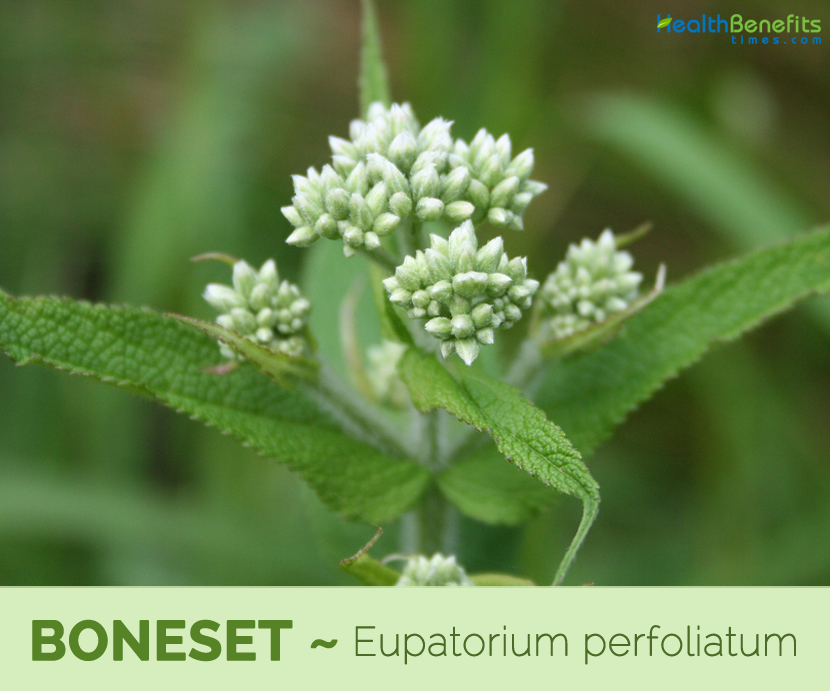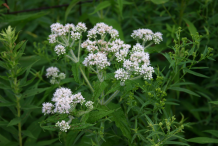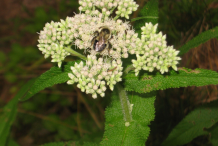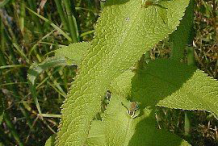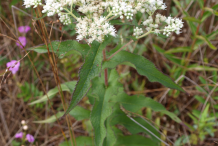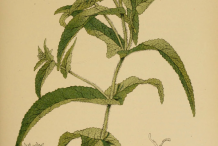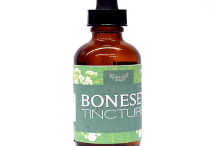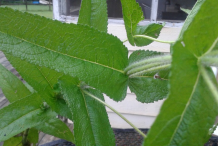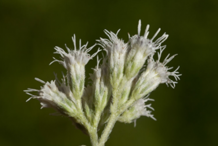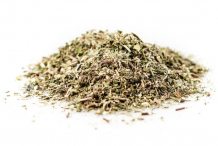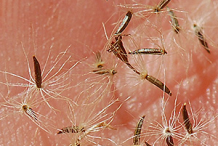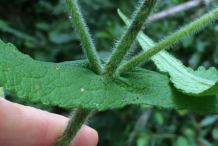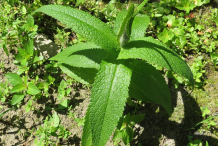Plant Descriptions
Boneset is a large, hairy, clump-forming, herbaceous perennial herb about 5 ft. (1.5 m); however it is usually only 2–4 ft. (0.6–1.2 m) tall. The plant is found growing in low woods, thickets, stream banks, meadows and prairies, woodland Garden, Dappled Shade and Shady Edge. It can easily grow in average, medium to wet soils and does well in both sandy and clay soils. Stem is erect stout, cylindrical hairy, thick and rough textured.
Leaves
Leaves are opposite, up to 8 inches long, 4x as long as wide, tapering to a pointed tip, toothed along the margins, and with a wide base distinctively surrounding the stem so as to appear that the stem pierced a single leaf at the midpoint of two blades. The pinnate vein network is very conspicuous. The leaf surfaces have fine hair, particularly the underside which also can have fine gland-dotting.
Flower
Flowers are about 1/2 inch across and are composed of 7 to 11 florets, each of which is about 1/6 to 1/5 inch across with a white corolla that has 5 spreading triangular lobes at the throat. The styles of the florets are much longer than the corollas and with a split tip are quite conspicuous. Five stamens surround and are appressed to the style. Anthers are a brownish color at maturity. The outside of the flower head is surrounded by 7 to 10 phyllaries in one or two series, each oblong with whitish pointed tips and surfaces finely hairy with glands. Flower stalks and corymb stalks are also hairy. Flowering normally takes place between July to September.
Fruit
Fruit is a dry, black seed with a small tuft. Fertile flowers produce a dry dark brown ribbed narrowly conic shaped cypsela, 1.5 – 2 mm long, with a fluffy pappus attached for wind dispersion and a pointed tip at the opposite end.
History
Boneset (Eupatorium perfoliatum) is native to eastern North America and was used by Native Americans to treat fevers, including dengue fever and malaria. Today, boneset is used mainly in homeopathic medicine for fevers, influenza (flu), digestive problems, and liver disorders. However, the use of boneset is limited because other drugs generally are more effective.
Boneset may be effective when taken by mouth as an immune stimulant and an anti-inflammatory agent. However, there is inadequate reliable information available about the effectiveness of boneset for its other uses.
Health benefits of Boneset
Boneset, especially the leaves and the flowering tops of the herb, possesses several properties that are beneficial for our body. Drinking a hot infusion prepared with boneset eases the symptoms of fever as it stimulates perspiration. In addition, boneset also releases phlegm and encourages its elimination by means of coughing. Listed below are few of the health benefits of using boneset
1. Alleviate fever
Boneset herb also known as the “sweat plant” can be used to alleviate various types of fevers, mainly through inducing sweat. As we know, Boneset is an effective diaphoretic agent which encourages sweating when consumed. By encouraging sweating, the natural diaphoretic agent forces the body to not only cool down but to also release several harmful toxins through the skin.
The natural herb has a long history of being effectively used particularly to treat influenza and fever. For instance, Boneset was effectively used to treat influenza during the First World War. This disease alone had led to the death of about 6 to 8 million people during that period.
2. Beneficial For Fractures
This particular natural herbal remedy is consumed to help repair broken or fractured bones, alleviate bone pain and even re-calcify teeth. This is because Boneset tea when regularly drunk increases blood circulation mainly to the “periosteum” which is the thin body tissue that surrounds human bones.
The natural herbal remedy has been scientifically proven to build a healthy bone mass, hence; can be used to alleviate various symptoms of muscular rheumatism as well as to treat arthritis. Apart from that, the natural herbal infusion also works on the nerves and joints both of which are major parts of the skeletal system.
3. Treat various respiratory issues
Boneset which is a powerful anti-catarrhal natural herb can be consumed to offer congestion relief through clearing the mucous present in the upper respiratory tract. The powerful herbal infusion can also be used to cure colds and flu.
Simply brew and drink hot Boneset tea. This will not only inspire perspiration but also help in relieving any aches or soreness related with the flu or cold. Boneset herbal tea is extensively used in Germany to treat multiple viral respiratory infections, including flu and the common cold.
4. Alleviate Digestive Issues
Boneset herbal tea can be consumed to address numerous digestive problems. The herbal remedy can be consumed to increase appetite, remove stomach parasites and worms, alleviate constipation, treat indigestion and offer relief against stomach muscle tension among other common digestive related problems. Boneset herbal tea is both a mild laxative and diuretic which makes it a powerful constipation remedy that can also be used to encourage urine flow.
5. Treat malaria
Boneset natural herbal remedy has been widely used for decades in the homeopathic medicine field to treat malaria. Research that was carried out on malaria-infested mice discovered that Boneset might be a good complimentary or alternative malaria medication. This is because the malaria-infested mice demonstrated a significant reduction in the rate of “Plasmodium” parasite multiplication. Plasmodium is the harmful parasite responsible for causing malaria.
6. Muscle Pain and Rheumatic Conditions
Boneset was used to ease the painful muscle and joint aches from fevers and rheumatic conditions, which may explain the common name “boneset.”
7. Boost the Immune System
Boneset is one of the good immune boosters. Natural herbal remedy plays a major role in motivating the production of white blood cells that efficiently work to destroy any disease-causing micro-organisms. The natural herb also improves both slow recovery and poor immune response.
Animal studies also revealed that Boneset consists of numerous chemical compounds (rutin and flavonoids) that work together to safeguard blood vessels against inflammation. Boneset’s powerful antibacterial property also helps the body to form a powerful shield against various disease-causing organisms.
8. Dengue Fever
Boneset is particularly effective at treating dengue fever, a mosquito-borne disease that causes severe joint aches.
Traditional uses and benefits of Boneset
- It is used in the treatment of influenza, colds, acute bronchitis, catarrh and skin diseases.
- It has been shown to encourage resistance to viral and bacterial infections, and reduces fevers by encouraging sweating.
- Leaves and flowering stems are antispasmodic, cholagogue, diaphoretic, emetic, febrifuge, laxative, purgative, stimulant and vasodilator.
- Hot infusion of the dried leaves and flowers is used as a very effective treatment to bring relief to symptoms of the common cold and other similar feverishness – it loosens phlegm and promotes its removal through coughing.
- This herb is almost unequalled in its effectiveness against colds.
- It is used in the treatment of rheumatic illness, skin conditions and worms.
- Homeopathic remedy is made from the fresh plant, harvested when it first comes into flower.
- It is used in the treatment of illnesses such as flu and fever.
- It was used by Native Americans to treat malaria.
- It helps reduce fever by promoting sweating, reduces aches and pains, and relieves congestion by loosening phlegm and promoting coughing.
- Boneset also encourages the immune system, which encourages the destruction of the influenza virus.
- Boneset may be taken in combination with cayenne, elder flowers, ginger, lemon balm, peppermint, or yarrow to treat influenza.
- For bronchial conditions, boneset may be taken with pleurisy root and elecampane.
- Native Americans also used Boneset for arthritis, indigestion, constipation and loss of appetite.
- Flavonoids found in boneset have shown promise as a natural herbal remedy to help fight against tumors.
- It has been used as an herbal folk medicine for fibromyalgia, diarrhea and intestinal worms.
- Boneset has the ability to reduce the symptoms of arthritis and malaria.
- It has ability to aid and calm skin diseases.
- Boneset has been used for treating yellow fevers and typhoid.
Ayurvedic health benefits of Boneset
- Fracture: Prepare a decoction of the leaves of Boneset. Take one cup two times a day.
- Yellow Fever: Prepare a decoction of the leaves of feverwort. Have one cup once a day.
- Wound: Make a Salve by combining powdered herb and Vaseline in equal parts. Use it externally.
- Cough: Take Slippery Elm, boneset, Licorice, Flax in equal quantity. Use it as a fomentation.
- Flu: Take one tbsp boneset, one tbsp Peppermint leaves and one tbsp Elder herb. Simmer Elder herb in 2 cups of water for 15-20 minutes and strain. Take Boneset and peppermint leaves in a separate container and add 2 cups of boiling water. Leave it covered for 30 minutes and then strain. Now mix both preparations and reheat the mixture. Drink one cup hot, every 15-20 minutes to get relief.
Preparation and Dosage
Boneset may be taken as tea or tincture.
Tea: Cold: 1ounce (25g) of herb in 1 quart (1 liter) boiling water let steep overnight, strain and drinks throughout day. The cold infusion is for the mucous membrane system and is a liver tonic.
Hot: 1 teaspoon herb in 8 ounces (237 ml) hot water, steep 15 minutes. Take 4 to 6 ounces (118 to177 ml) up to 4 times per day. Note: Boneset is only a diaphoretic when hot and should be consumed hot for active infections, chills and fevers.
Tincture: Use fresh herb in flower 1:2 with 95 percent alcohol, use 20 to 40 drops up to 3 times day in hot water. Dry herbs: 1:5 with 60 percent alcohol use 30 to 50 drops in hot water up to 3 times a day. In acute viral or bacterial upper respiratory infections, use 10 drops of tincture in hot water every half hour up to 6 times a day. In chronic conditions when the acute stage has passed but there is continued chronic fatigue and relapse, use 10 drops of tincture in hot water 4 times a day.
Flu treatment using dried boneset
- one ounce of dried boneset leaf
- one quart of boiling water
- a quart mason jar
Directions
- Put the dried boneset in the quart jar and pour enough boiling water over it to fill the jar.
- Let this infusion steep for four hours.
- Strain and drink.
- This flu remedy is very bitter tasting. We recommend heating it back up after straining it, and drinking it warm.
Precautions
- Some herbalists recommend it should not be used with a high fever in excess of 102F.
- Also suggest to not using boneset for more than 6 months.
- As potentially toxic should not be used during breast feeding.
- Ingestion of large amounts of teas or extracts may result in severe diarrhea.
- Hot infusion in quantity may cause vomiting.
- Plant only contains trace amounts of pyrrolizidine alkaloids; those who are suffering from liver disease should not use it.
- Boneset may cause an allergic reaction in people who are sensitive to plants in the Asteraceae/Compositae family.
- Boneset should never be ingested fresh, as the fresh plant is toxic due to a volatile oil called tremerol.
- Boneset may cause excessive fluid loss from the body, possibly also decreasing the body’s potassium supplies. Low potassium levels can result in muscle weakness and potentially dangerous changes in heart rhythm.
References:
https://plants.usda.gov/core/profile?symbol=eupe3
https://www.itis.gov/servlet/SingleRpt/SingleRpt?search_topic=TSN&search_value=35980#null
https://npgsweb.ars-grin.gov/gringlobal/taxonomydetail.aspx?id=16330
http://davesgarden.com/guides/pf/go/1118/
http://www.botanical.com/botanical/mgmh/b/bonese65.html
http://eol.org/pages/475561/overview
http://www.pfaf.org/User/Plant.aspx?LatinName=Eupatorium+perfoliatum
http://www.missouribotanicalgarden.org/PlantFinder/PlantFinderDetails.aspx?kempercode=c730
https://www.nps.gov/miss/learn/nature/prairestbonel.htm
https://www.drugs.com/npp/boneset.html
http://www.encyclopedia.com/plants-and-animals/plants/plants/boneset
https://en.wikipedia.org/wiki/Eupatorium_perfoliatum
https://www.wildflower.org/plants/result.php?id_plant=eupe3
http://klemow.wilkes.edu/Eupatorium.html
Comments
| Boneset Quick Facts | |
|---|---|
| Name: | Boneset |
| Scientific Name: | Eupatorium perfoliatum |
| Origin | Eastern United States and Canada, with a range from Nova Scotia to Florida |
| Shapes | Dry, black seed with a small tuft of hair to carry it off in the wind. |
| Taste | Astringent and strongly bitter |
| Health benefits | Alleviate fever and Treat various respiratory issues |
| Name | Boneset |
|---|---|
| Scientific Name | Eupatorium perfoliatum |
| Native | Eastern United States and Canada, with a range from Nova Scotia to Florida |
| Common Names | Boneset , thoroughwort, sweat plant, vegetable antimony , feverwort , agueweed , Indian sage , sweating plant , eupatorium , crosswort , thoroughstem , thoroughwax , wild Isaac, Wood boneset, teasel, tearal, wild sage |
| Name in Other Languages | English: Chapman’s thoroughwort, boneset, common boneset, thoroughwax, thoroughwort, perfoliate thoroughwort, boneset thoroughwort, bonset, Common Thoroughwort, Indian Sage, French: eupatoire perfoliée, herbe à souder German: durchwachsener Wasserdost Swedish: läkeflockel |
| Plant Growth Habit | Large, hairy, clump-forming, herbaceous perennial herb |
| Growing Climate | Low woods, thickets, stream banks, meadows and prairies, Woodland Garden Dappled Shade and Shady Edge |
| Soil | Easily grown in average, medium to wet soils. Does well in both sandy and clay soils |
| Plant Size | 5 ft. (1.5 m), it is usually only 2–4 ft. (0.6–1.2 m) tall |
| Stem | Erect stout, cylindrical hairy, thick, rough textured stem |
| Leaf | Large, opposite, united at the base, lance-shaped, 4 to 8 inches long (the lower ones being the largest), tapering to a sharp point, the edges finely toothed, the veins prominent, the blades rough above, downy and resinous and dotted beneath. |
| Flower | Large, numerous, white or purple flower clusters, which appear at the ends of the branches, are comprised of 10–20 florets |
| Flowering Season | July to September |
| Fruit Shape & Size | Dry, black seed with a small tuft of hair to carry it off in the wind |
| Flavor/Aroma | Faint aroma |
| Taste | Astringent and strongly bitter |
| Plant Parts Used | Leaves, stem and flowers |
| Health Benefits |
|
| Other Facts |
|


